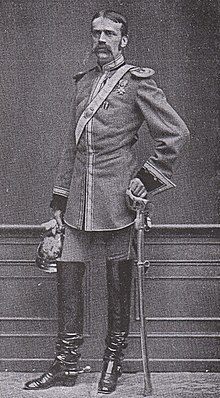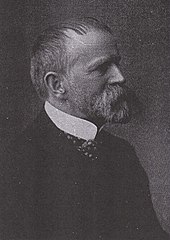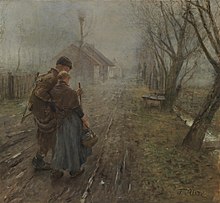Fritz von Uhde
Fritz von Uhde (born May 22, 1848 in the Wolkenburg estate , Saxony , † February 25, 1911 in Munich ; born Friedrich Hermann Carl Uhde ) was a Saxon cavalry officer and painter . His style ranged between realism and impressionism . He also painted religious pictures.
family
He came from the old merchant, civil servant and pastor family Uhden from originally Gardelegen in the Altmark, where among others perform 1393 Ciriacus and Henning Uden, 1419 the brothers Niclas and Ciriacus Uden and 1493 mayor Udo Udonis. It is documented in Egeln near Magdeburg in 1552. The secured family line begins with Christian Röttger Heinrich Uhde, a merchant in Egeln, and Dorothea Rulmann, who was married there on June 6, 1608.
Uhde is the son of Bernhard von Uhde (1817–1883), district director of Zwickau, Saxon secret government councilor and president of the Evangelical State Consistory in Saxony, Saxon nobility since April 3, 1883, and Anna Auguste Clara Nollain (1824–1898) , honored at the suggestion of Empress Augusta with the Cross of Merit for Women and Virgins (1870/71). She was the daughter of Chief Forestry Secretary Friedrich Nollain and Minna Heitmann. The Nollains immigrated to Germany from France. Bernhard von Uhde and his wife Anna Auguste Clara had three children, Anna (1846–1904), Fritz and Clara (1850–1920).
Fritz von Uhde married Amalie von Endres (1849–1886) on May 11, 1880 in Munich, daughter of the Higher Appeal Court counselor Nikolaus von Endres and Amalie Hubert. She died in childbed giving birth to her third daughter. Uhde did not remarry and became a "single parent".
- Anna von Uhde (1881–1970), remained unmarried and became a painter
- Amalie von Uhde (1882–1977), married church minister Eduard Pflügel: Children: Elisabeth Pflügel, Fritz Pflügel
- Sophie von Uhde (1886–1956) became a travel writer, married Ludwig Drechsel, an officer, divorced after 1911. Daughter: Lotte
The children's pictures of his three daughters were immortalized in several of his works.
Life
Child and student
Uhde was born in the revolutionary year of 1848 at Wolkenburg Castle , where his father was the last court director in Einsiedel and he spent his earliest childhood with his older sister before the family moved to Zwickau . Here he had his younger sister at the age of three, spent the rest of his childhood and then his youth and school days as a threesome. The artistic disposition came from the parents and was encouraged at an early age. The father was a skilful pastelist, the mother and sisters also painted, while he practiced Menzel's technique with increasing dexterity during his high school days in Dresden ( Vitzthumsches Gymnasium ) and Zwickau. An artist named Karl Mittenzwei who moved to Zwickau gave drawing lessons to the Uhde children and took special care of Fritz. In 1864, his father drove with him and some drawing samples to Munich to see Wilhelm von Kaulbach , who did not like Menzel's art direction, but recognized the talent, which was also confirmed by Julius Schnorr von Carolsfeld , with which the father's wish to pursue a legal career was off the table.
Student at the art academy
When in 1866 enthusiasm for the opponents of Prussia aroused and Uhde wanted to join the Austrian army after graduating from high school, the parental veto ensured that the eighteen-year-old enrolled at the art academy in Dresden . He came into the lowest class, in which plaster masks and busts had to be pedantically drawn with needle-sharp charcoal or hard pencil. The unease grew and after barely three months the training to become an artist was broken off and a career as an officer started.
Professional officer in Saxony from 1867–1877
On October 1, 1867 Uhde joined the 1st Uhlan Regiment of the Saxon Army with a garrison in Oschatz as portepéefähnrich or avantageur . Soon he became ensign and in 1868 secondary lieutenant in the Guard-Reiter-Regiment Dresden / Pirna. In July 1870 he marched from his garrison in Pirna to war against France . He became an orderly officer of the 1st Cavalry Brigade and took part in the assault on Saint-Privat on August 8, 1870 , which moved him for a long time. Awarded the Knight's Cross II. Class of the Albrecht Order , he was transferred to the 5th Squadron in the 2nd Uhlan Regiment No. 18 in Rochlitz in 1872 . The following year he was appointed adjutant of the 2nd Cavalry Brigade No. 24 to Leipzig and, with a patent from May 27, 1873, he was promoted to prime lieutenant . In 1874/75 Uhle was adjutant of the 3rd Cavalry Regiment and then with the Karabiner Regiment . Instructed in the secrets of oil painting by the battle painter Ludwig Albrecht Schuster (1824–1905). a. the battle of Sedan and revenge . In 1876 he was transferred to the 2nd Heavy Rider Regiment in Borna , where horse studies were carried out.
Professional painter in Munich
In 1876 Uhde traveled to Vienna to see Hans Makart , who turned him down as a pupil and referred to Karl Theodor von Piloty in Munich. In the summer of 1877 Uhde moved to Munich, initially as an officer à la suite in his regiment. The Saxon Minister of War Alfred von Fabrice (1818-1891) had personally recommended that he go to his brother's embassy in Munich as a military attaché . In 1878, at the age of thirty, Uhde ended his active military career and characterized the reserve captain in the carbine regiment. Two uniform photos from the Atelier Franz Werner in Munich come from this time to attend the art academy there. He did not succeed in finding a student with Piloty, Wilhelm von Diez or Lindenschmit. On the advice of Franz von Lenbach, he began studying the old masters in the Pinakothek. Uhde developed a particular preference for the old Dutch, which he studied diligently in Munich.
At the Saxon envoy in Munich, Oswald von Fabrice (1820–1898), he met the Hungarian painter Michael Munkacsy, who had become famous in the capital of France and who suggested that he come to Paris in autumn 1879 . Uhde painted here for a few weeks in his studio, but otherwise continued his studies in the Dutch. His first pictures are under her influence: The Singer , The Learned Dogs , The Family Concert and The Dutch Restaurant .
A trip to Holland in the summer of 1882 confirmed Uhde in his coloristic principles, into which he had meanwhile also included those of the Parisian light painters. His next pictures The Arrival of the Organ Grinder (Memory from Zandvoort) and The Drumming Exercise of Bavarian Soldiers , however, were only the preparation for the tasks that he had set himself as the main goal of his art.
Uhde created his first religious painting in 1884 with “Let the little children come to me”. Due to his new coloristic view and his naturalistic formation of forms, he wanted to put the history of the New Testament in close relation to the present and bring it to a new, deep and simple representation with strong emphasis on the lower classes. His motif of the poor man Jesus was ultimately taken up again in expressionist church painting. For example in the picture Heiland es 20th Century by Peter Hecker . For a long time, the naturalistic art movement was frowned upon in the church, as it was not appropriate that people or events in salvation history were merely viewed as historical events or even profaned. Fritz von Uhde was thus one of the forerunners of modern church art of the 20th century. In 1892 he became chairman of the secessionist Free Association of the XXIV
In 1896, ten years after the death of his wife, Uhde bought a country house in Percha on Lake Starnberg , where he mostly spent the summer. Here he painted his three daughters "In der Gartenlaube" with impressionistic elements, which he used as early as 1892 in "Zwei Mädchen im Garten". The court photographer M. Obergaßner received a photo from 1899 of Uhde with his daughters Sophie, Amalie, Anna and the dog Kitsch in the garden on Lake Starnberg. Uhde, Hugo von Habermann and Eduard Zimmermann had their studios in Müchnen on Theresienstrasse .
He was one of the preferred selection of contemporary artists that the "Committee for the Procurement and Assessment of Stollwerck Pictures" suggested to the Cologne chocolate producer Ludwig Stollwerck to commission them with drafts.
Uhde won the title in Munich . Prof. awarded and he was entrusted with a teaching position at the art academy. In the joint Xth exhibition of the Munich Secession: The German Artists 'Association in Munich in 1904, Fritz von Uhde was already a member of the jury of both artists' associations; he exhibited another picture there with the title Im Hausgarten . Two years later he is also listed as a full member of the German Association of Artists .
Fritz von Uhde died in Munich on February 25, 1911 at the age of 62.
The majority of his artistic work was often rejected by the official art critics as well as by the public because of depictions of the "ordinary and ugly". Because of her close connection to nature and her closeness to Rembrandt , Uhde also found numerous admirers.
Works (selection)
In 1908 Hans Rosenhagen counted a total of 285 works. 78 had a religious content (14 from the Old and 64 from the New Testament), 10 related to history and mythology, 101 reproduced scenes from life (36 indoors, 47 outdoors). 55 were single figures (24 men, 17 women and 14 children) and 22 are portraits. Here is a selection in chronological order:
|
|
|
Honors
- 1870/71 Prussia: Iron Cross 2nd class
- 1870/71 German Empire: War memorial for 1870–71
- 1873 Leipzig: first exhibition, Battle of Sedan causes a stir
- 1883 Paris Salon: Honorable mention for The organ grinder is coming
- 1884 Berlin: Medal for Let the Little Children Come to Me
- 1884 Paris: Medal for Let the Children Come to Me
- 1884 Munich: Medal for Let the little children come to me
- 1885 Paris: Medal in the “Salon” for Let the little children come to me
- 1886 Munich: Professor title and teaching assignment
- 1888 Vienna: gold medal for Come Lord Jesus, be our guest
- 1889 Munich: Medal for Let the little children come to me
- 1889 Paris: Grand Prix for Let the Children Come to Me
- 1890 Paris: Grand Prix
- 1890 Paris Member of the Société nationale des beaux-arts (SNDBA)
- 1890 Munich: Honorary member of the Academy of Fine Arts
- 1891 Vienna: Archduke Karl Ludwig Protector Medal
- 1891 Vienna: Honorary diploma for the heavy walk
- 1891 France: Knight of the Legion of Honor
- 1891 Saxony (duchies): Knight's Cross of the Ernestine House Order
- 1891 Vienna: Honorary diploma
- 1893 Paris: Member of the Société nationale des beaux-arts
- 1896 Bavaria: Knight's Cross of the Order of Merit of the Bavarian Crown
- after 1897 Prussia: centenary medal (100th birthday of Wilhelm I.)
- 1902 Bavaria: Bavarian Maximilian Order for Science and Art
- 1902 Officer of the Legion of Honor
- 1902 Sweden Wasaorden : Commander II class
- 1909 Leipzig: Dr. hc the theol. Faculty
- xxxx Italy: Officer's Cross of St. Mauritius and the Order of Lazarus
- xxxx Spain: Order of Isabella the Catholic : Commander
- xxxx Norway: Order of Saint Olav : Knight 1st class
- 1911 Munich: Hugo von Habermann pays tribute to the deceased as the founder of "modern painting"
literature
- Ekaterini Kepetzis: Uhde, (Friedrich Hermann Karl) Fritz von, German painter. In: Biographisch-Bibliographisches Kirchenlexikon (BBKL). Volume 22, Bautz, Nordhausen 2003, ISBN 3-88309-133-2 , Sp. 1372-1396.
- Otto Julius Bierbaum : Fritz von Uhde , Albert, Munich 1893
- Albert P. Bräuer: Fritz von Uhde , Verlag der Kunst, Dresden 1985
- Bettina Brand: Fritz von Uhde. The religious work between artistic intention and the public , dissertation, University of Heidelberg 1983
- Hans Julius Duncker , Uhde family , Verlag CA Starke, 1940 (Contents of the first delivery: Prehistory of the Uhdes, the collection of documents on Uhde history and the descendants of lines 1–3).
- Genealogisches Handbuch des Adels , Adelslexikon Volume XV, Volume 134 of the complete series, CA Starke Verlag, Limburg (Lahn) 2004, ISBN 3-7980-0834-5 , pp. 110–111
- Dorothee Hansen (Ed.): Fritz von Uhde. From Realism to Impressionism , Cantz, Ostfildern-Ruit 1998, ISBN 3-7757-0789-1
- Hermann Lücke: Fritz von Uhde , Seemann, Leipzig 1887 (special print from the magazine for fine arts )
- Uhde, Fritz von in: Harald Olbrich (Hrsg.): Lexikon der Kunst. Architecture, fine arts, applied arts, industrial design, art theory . Volume VII: Stae – Z , EA Seemann Verlag, Leipzig 2004, ISBN 3-86502-084-4 , p. 483.
-
Fritz von Ostini ,
- Uhde . With 120 illustrations, including 2 in color reproduction (= artist monographs ). Bielefeld and Leipzig, 1911.
- Fritz von Uhde . In: Die Kunst , XXIII. Vintage. Pp. 1–16 ( online )
- Elisabeth Peters : Church wall painting in the Rhineland 1920–1940. A contribution to the history of the Cologne Institute for Religious Art . CMZ-Verlag, Rheinbach, 1996, ISBN 978-3-87062-026-4 .
- Fritz von Uhde, biographical sketch , printed in Bettina Brand in 1890: Fritz von Uhde. The religious work between artistic intention and the public , dissertation, University of Heidelberg 1983, p. 5
- Gustav Uhde, gender register of the Uden or Uhden , printed by Robert Lucas, Breslau 1855, No. 62 and 68
- Hans Rosenhagen , Uhde. The master's painting in 285 illustrations (= classics of art in complete editions, volume 12). Stuttgart and Leipzig, Deutsche Verlagsanstalt, 1908
- Sarah Hoke: Fritz von Uhde's “Nursery”: The representation of the child in his play and living environment , Göttingen University Press ISBN 978-3-941875-90-6 open access version
- Hermann Uhde-Bernays : Uhde, Fritz (Friedrich Karl Hermann) from . In: Hans Vollmer (Hrsg.): General lexicon of fine artists from antiquity to the present . Founded by Ulrich Thieme and Felix Becker . tape 33 : Theodotos vacation . EA Seemann, Leipzig 1939, p. 545-548 .
- Gerd-Helge Vogel : The divinity of light. Fritz von Uhde (1848–1911) on the 100th anniversary of his death. Exhibition catalog on life, work and cultural environment. Zwickau municipal museums, art collections; Municipal museums Limbach-Oberfrohna, Wolkenburg Castle 2011, ISBN 978-3-933282-37-8 .
-
Gerd-Helge Vogel :
- In search of the light. The painter of divine light, Fritz von Uhde, meets Louis Douzette , the Pomeranian magician of the night. Thomas Helms Verlag, Schwerin 2012, ISBN 978-3-940207-99-9 .
- Fritz von Uhde 1848–1911. Becoming an artist from the Zwickau Muldenland. In: Gerd-Helge Vogel (Ed.): Fritz von Uhde 1848–1911. Contributions of the 1st International Wolkenburg Symposium on Art. Lukas Verlag, Berlin 2013, ISBN 978-3-86732-147-1 .
Web links
- Literature by and about Fritz von Uhde in the catalog of the German National Library
- Wolkenburg-Kaufungen: biography and selection of works
Individual evidence
- ↑ German Gender Book , Volume 128, p. 354.
- ↑ Fritz von Ostine writes on page 11 in addition (?) To Duncker that the maternal grandfather was general director of the royal museums in Dresden and that he did his best in setting up the armory. He is likely to be the author of the publication “The royal rifle gallery in Dresden by Friedrich Nollain with 2 lithographs, Dresden 1835”, which is referred to in Rudolph Weigel's art catalog, Leipzig 1850 under no.
- ↑ Albert Peter Bräuer dedicates his article to Fritz von Uhde, published around 1980 by VEB Verlag der Kunst Dresden in the series “Painter and Work”, to the artist's granddaughter, Elisabeth Vogel from Icking near Munich.
- ↑ Uhde 1906/07 in an interview with Georg Muschner from Ulf Küster Fritz von Uhde - biography
- ↑ 1883 Rittmeister of the Reserve and on August 22, 1887 in the 40th year of service, farewell with the uniform of the carbine regiment.
- ↑ A. von Wilke: At Fritz von Uhde. in: Die Woche, modern illustrated magazine, Verlag August Scherl, Berlin, No. 39, March 1, 1899.
- ↑ Grete Hess: Atelie in Munich. Retrieved November 1, 2019 .
- ↑ Detlef Lorenz: Advertising art around 1900. Artist lexicon for collecting pictures. Reimer-Verlag, 2000.
- ^ Exhibition catalog X. Exhibition of the Munich Secession: The German Association of Artists (in connection with an exhibition of exquisite products of the arts in the craft) , Verlaganstalt F. Bruckmann, Munich 1904 (p. 32: Uhde, Fritz von, Munich. Catalog number 165: Im Home garden. )
- ↑ s. List of members in the catalog of the 3rd German Artists Association , Weimar 1906. P. 57 online (accessed April 20, 2016)
- ↑ Hans Rosenhagen: Uhde. The master's painting in 286 illustrations , (= classics of art in complete editions, 12th volume). 1908, pp. 285-299.
| personal data | |
|---|---|
| SURNAME | Uhde, Fritz von |
| ALTERNATIVE NAMES | Uhde, Friedrich Hermann Carl (maiden name) |
| BRIEF DESCRIPTION | Saxon cavalry officer and painter |
| DATE OF BIRTH | May 22, 1848 |
| PLACE OF BIRTH | Wolkenburg Manor District , Saxony |
| DATE OF DEATH | February 25, 1911 |
| Place of death | Munich |











